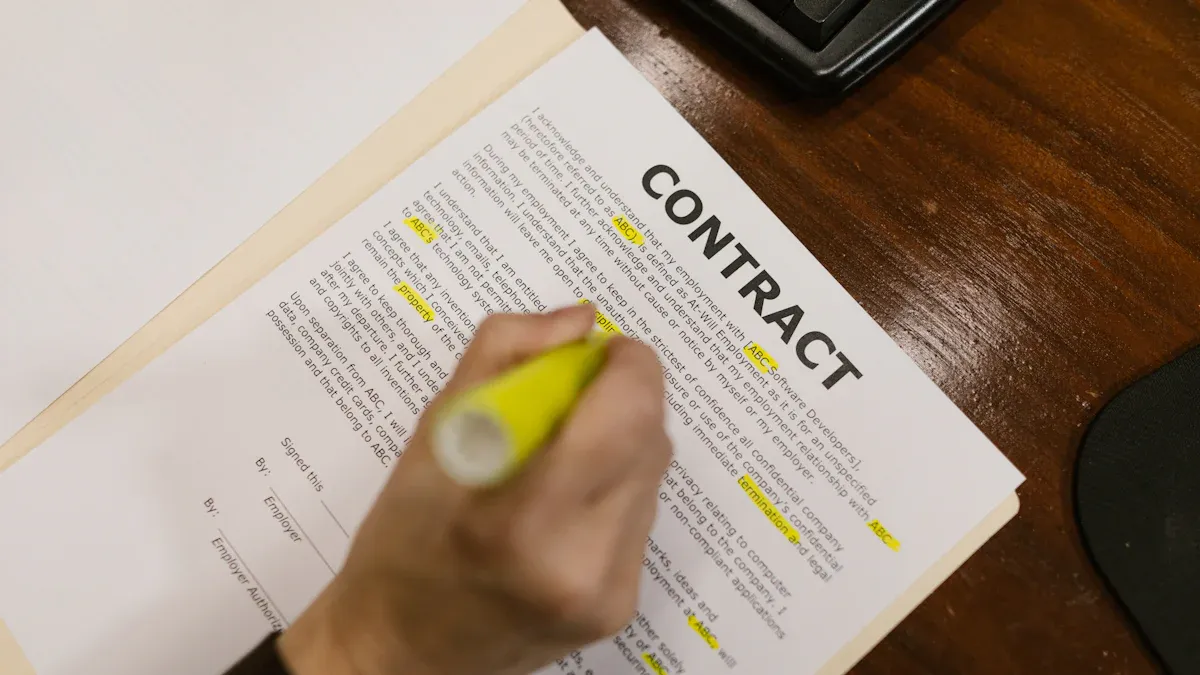From Case Law to Contracts How AI Is Shaping Legal Research and Drafting

AI for law has transformed how legal research is conducted in law offices. It replaces slow, manual tasks with intelligent computer assistance. Lawyers now use AI for law to review over 1,000 pages each hour, compared to just 100 pages per hour before.
Metric | Before AI for Law | After AI for Law Implementation |
|---|---|---|
Research Time | 8 hours/case | |
Document Processing | 100 pages/hour | Over 1,000 pages/hour |
Increased Case Capacity | Baseline | 30% more cases, same team size |
Compliance Review Accuracy | Variable | Fewer errors |
AI for law helps lawyers accomplish more work with greater accuracy. It also reduces mistakes, giving legal teams more time to strategize their cases. By making legal research more precise, AI for law allows lawyers to focus on complex legal issues. This technology continues to evolve, streamlining routine tasks and enhancing the efficiency of legal work.
Key Takeaways
AI makes legal research and document review faster. Lawyers can do more work in less time and make fewer mistakes. - Advanced AI tools find important cases and risks people may not see. This helps lawyers make better choices. - AI writes contracts and legal documents fast. This saves time and keeps the work good. - Using AI needs careful checks to keep client privacy safe. It also helps avoid bias and makes sure results are right. - Lawyers need to keep learning and use AI the right way. This helps them get good results and earn trust from clients.
AI for Law: Legal Research

Automation in Research
AI for law has changed how lawyers do legal research. Before, lawyers read case law and statutes by hand for hours. Now, ai in legal research uses ai-powered automation to do these tasks. This means legal teams can look at thousands of documents much faster. For example, a big law firm used ROSS Intelligence and cut research time by 60%. Lawyers used to spend 20 hours a week on research. Now, they only need a few minutes for each search. AI in legal research also finds important case rulings that people might miss.
Legal research tools with artificial intelligence search huge databases in seconds. Machine learning algorithms get better over time. They find patterns and connections that people may not see. AI tools also help with e-discovery by sorting data quickly. This makes document sets ready for court in hours, not weeks. Automated compliance checks lower mistakes and help follow rules. Because of this, legal professionals save time and make fewer errors. They can spend more time on strategy and helping clients instead of searching by hand.
Tip: AI in legal research does not replace legal judgment. It helps lawyers do their work better and gives them more time for hard analysis and helping clients.
Advanced Search Tools
Advanced search tools are now very important in ai-driven legal research. These tools use artificial intelligence and machine learning to search big legal databases. They find important precedents and suggest related cases or statutes that might be missed. Features like Boolean operators, jurisdiction filters, and keyword relevance help lawyers find the best case law fast.
Citation services like Shepard’s and KeyCite check if cases are still good law and help find related authorities. AI-powered litigation analytics look at old case data to give insights and help with strategy. Tools like Visualping watch for new laws and rules, so legal professionals stay up to date. Using these tools in research helps find and use the right legal precedents.
Legal professionals often use database searches and check main sources. They use advanced search tricks to skip unneeded material and focus on what matters. Automated tracking software watches for law changes. Teamwork and learning help everyone stay current.
AI Platform / Firm | Improvement Metric | Description / Example |
|---|---|---|
ROSS Intelligence | ~60% reduction in research time | NLP platform reduced research time from ~20 hours/week to under 2 minutes per query. |
LexisNexis Lexis+ | Substantial reduction in research time and improved precision | AI-powered smart search enables faster retrieval of relevant statutes and case law. |
Casetext CARA AI (WilmerHale) | 40% reduction in brief preparation time | AI-assisted brief analysis improved case preparation speed and accuracy. |
Predictive Analytics
Predictive analytics is a big step forward in ai for law. These tools use artificial intelligence to look at thousands of old cases. They find what affects court decisions and give odds of winning a case. Some predictive analytics tools are 81% accurate at guessing judge rulings. They look at judge background, demographics, and case facts to predict results.
Lawyers use predictive analytics to make smart choices about lawsuits, settlements, or changing plans. By looking at old settlements, these tools help with negotiation by showing data on payment ranges. Predictive analytics also study judge and opposing lawyer behavior. This helps lawyers plan arguments and guess what others will do. Firms can use resources better by knowing which cases may settle early or take longer.
Predictive analytics looks at thousands of old cases to find what affects court decisions.
It helps lawyers make smart choices about lawsuits, settlements, or changing plans.
By looking at old settlements, predictive analytics helps with negotiation using real data.
It studies judge and opposing lawyer behavior to help plan legal arguments.
Predictive analytics helps use resources better by finding cases that may settle early or take longer.
AI in legal research keeps getting better and offers new ways to work faster and more accurately. Legal professionals who use these tools get ahead. They can get better results for clients and keep up with changes in the legal world.
Legal Document Drafting with AI

Automated Drafting
AI has changed how law firms write legal documents. Generative AI now makes first drafts of contracts and briefs. Lawyers do not have to start from nothing. They look at drafts made by AI and make changes. This saves time and helps lawyers be more accurate. AI tools like Thomson Reuters CoCounsel search many documents and legal sources. They find templates and important citations. These tools help lawyers make strong arguments and follow legal rules.
Many law firms use document automation for boring tasks. AI-powered contract generators like Legittai make first drafts from what users type. Lawyers can then work on harder legal problems instead of simple writing. AI also checks if documents follow the rules, so mistakes happen less. A study showed that 79% of lawyers use AI, and drafting legal documents is a main use. This change lets legal teams do more work without losing quality.
Note: Generative AI makes legal writing better. A study by two big law schools found that AI drafting tools made writing clearer and more organized. Professionalism also improved. Productivity went up by 140%, and work finished 37% faster. These results show that AI helps lawyers write faster and better.
AI helps by doing boring drafting jobs.
It lowers mistakes and makes sure documents follow the rules.
Law firms save time searching documents and get more done with AI.
Banks use AI-made legal reports to help new clients faster.
AI can handle lots of legal documents without losing quality.
Contract Review
AI contract review is now a big part of legal writing. AI checks contracts much faster than people. AI can review a contract in just 26 seconds. People may need up to 92 minutes for the same job. AI also makes fewer mistakes. The error rate for AI is about 3%. For people, it is 15%. This means AI is five times more correct.
Metric | AI Contract Review | Human Contract Review | Improvement Factor |
|---|---|---|---|
Average Review Time | 26 seconds | 92 minutes | Over 200 times faster |
Error Rate | 3% | 15% | 5 times fewer errors |
Accuracy Compared to Lawyers | 10% higher | Baseline | Significant accuracy gain |
AI contract review tools find small problems and risks that people may miss. These tools help legal teams follow rules and policies. Lawyers can spend more time on important work like planning and helping clients. Companies using AI for contract review close deals faster, save money, and make clients happier. They watch review time, cost, and accuracy to see how AI helps.
Tip: AI contract review is faster and makes legal work better. Legal teams can check more contracts, make fewer mistakes, and help clients more.
Risk Identification
AI is very important for finding risks in legal writing. AI gives risk scores to contracts by looking at what is inside. It checks if contracts follow rules and company policies. AI makes due diligence faster by checking many contracts quickly. Automated contract analysis pulls out clauses, compares templates, and reviews fast.
AI shows which clauses may need more work or changes.
Predictive analytics help AI guess legal risks before they happen.
AI learns over time and gets better at finding problems.
AI always checks for rule-following, strange things, and risk scores.
AI tools like Bloomberg Law Contract Solutions compare draft clauses to big databases. Natural language processing helps AI read legal text and find hidden risks. Automated contract review finds risks, suggests changes, and adds notes to save time. AI also manages NDAs, making sure they are correct and follow the rules.
Callout: AI risk identification helps lawyers see problems early. This lets them act fast and protect their clients.
Legal document drafting with AI uses automation, document analysis, and risk management. Law firms using AI can do more work, make fewer mistakes, and get better results for clients. AI keeps changing law by making legal writing faster, more correct, and more trustworthy.
AI Integration
Workflow Best Practices
Law firms use ai to make work faster and easier. Many lawyers use ai-driven solutions to do simple jobs. These tools help sort, summarize, and edit legal files. AI-powered assistants can set up meetings and help with daily tasks. This makes work smoother for everyone. A report says 81% of legal professionals use ai to work better and help clients.
AI integration brings new ways to manage documents. Translation and summarization tools help people understand and share legal papers. Case management software, like Opus 2 Cases, helps teams plan by automating document checks and trial prep. Firms like Linklaters use ai workflows to make court cases faster and give more value to clients.
Tip: Teams should keep learning to use ai well. Regular checks and feedback help keep work correct and useful.
Picking the right ai tool stack is important. Teams need to know what they need, pick good platforms, and work together in real time. This helps manage documents and keeps law firms ahead in legal tech.
Security & Oversight
Security and oversight are very important for ai integration in law. Law firms have private data, so they must keep it safe. Certified platforms, strong encryption, and regular checks protect data. Document systems must follow privacy rules to stop leaks.
AI-driven solutions like Kira Systems and Lex Machina show how automation saves time and boosts accuracy. But these tools also show why oversight matters. Firms must protect data, watch for bias, and make sure everything is clear. Training and rule checks help teams use ai the right way.
Case studies show that being open and fair builds trust in law. Firms that focus on oversight and security keep clients’ trust and follow the rules. By using ai with good oversight, law firms can lower risks and get better results.
Ethics & Privacy
Bias & Fairness
Legal professionals need to think about bias and fairness when using ai in legal research and drafting. Ai can spot unfair patterns in court decisions. This helps treat different groups more equally. Some ai systems have found problems in sentencing. These findings led courts to make changes. Ai also helps decisions stay the same by following set rules. But some systems, like COMPAS, have shown racial bias. This happens when they judge risk levels for defendants. Because of this, careful oversight is needed.
Countries like China and Estonia use ai to make courts fairer and faster. They do this under national digital policies. But it is still hard to be fully open about how ai works. Many experts say regular checks, clear rules, and human review are important. These steps help lower bias. Ai can help make legal choices fairer. But professionals must use it carefully and keep looking for problems.
Note: Training and public awareness help make sure ai supports justice. This stops new types of discrimination from happening.
Confidentiality
Confidentiality is very important when law firms use ai. Lawyers must keep client information safe. They must follow strict rules, like Model Rule 1.6. This rule says lawyers must stop others from seeing client data without permission. Before putting documents into ai systems, lawyers should know the risks. Surveys show 88% of legal professionals worry about data safety and client privacy with generative ai.
Courts now want lawyers to say when they use ai in legal work. They must also show that no private information was leaked. Groups like the American Bar Association and state task forces say accountability and transparency are needed. International rules, like those from the EU and China, also focus on data safety. Law firms should use strong cybersecurity, check for problems, and get client consent before using ai tools.
Use cybersecurity controls and check often.
Think about risks before sharing data with ai.
Always get client consent first.
Reliability
Reliability is very important for ai in legal work. Some ai systems can make mistakes. They might create fake legal citations or give wrong facts. In one case, two lawyers sent a brief with six fake cases made by an ai tool. This shows why human review is needed.
Ai models can also keep old biases from their training data. This can hurt fairness. To make ai more reliable, legal teams should train ai with legal data and always watch its use. Privacy methods, like adding noise to training data, help keep information safe. Strong cybersecurity, like checking for strange activity and user checks, keeps ai systems safe from misuse.
Tip: Human review and regular updates make ai more reliable and trustworthy in legal work.
AI has changed how lawyers do research and write documents. It helps them work faster and make fewer mistakes. Legal professionals can use technology and their own skills together by doing these things:
Keep learning about AI tools to know how they work.
Let AI handle simple jobs so work gets done faster.
Work with others using AI systems to help the team.
Check what AI does often to make sure it is right.
Always be open and take responsibility for actions.
Keep client information safe with strong protection.
Show care and build trust with clients.
Make easy-to-follow rules for using AI the right way.
Learning all the time helps lawyers keep up and do well as the legal world changes.
FAQ
What types of legal documents can AI draft?
AI can write contracts, briefs, NDAs, and memos. Many law firms use AI to make first drafts and templates. These tools help lawyers finish work faster and make fewer mistakes.
Tip: Lawyers need to check AI-made documents before giving them to clients.
How does AI improve legal research accuracy?
AI looks through big databases and finds cases fast. It uses machine learning to find patterns and suggest important rulings. This helps lawyers get the right information quicker than searching by hand.
Is AI secure for handling confidential legal data?
Most AI platforms use strong encryption and follow privacy rules. Law firms must pick certified tools and watch how data is used. Regular security checks help keep client information safe.
Always ask clients before using AI tools.
Use platforms with good security features.
Can AI replace lawyers in legal work?
AI helps with simple jobs but cannot take a lawyer’s place. It supports research, drafting, and review. Lawyers use their own judgment and experience to make final choices.
Note: AI is a tool, not a replacement for legal expertise.
What are the risks of using AI in law?
AI can make mistakes, miss details, or show bias from its training data. Lawyers must check what AI does and make sure it is fair. Regular checks and updates help lower these risks.
See Also
Inside Look At AI Data Bot Created By Momen Team
Learn Ways To Earn Income Using AI In 2025
Steps To Create And Deploy A Successful LLM Agent
